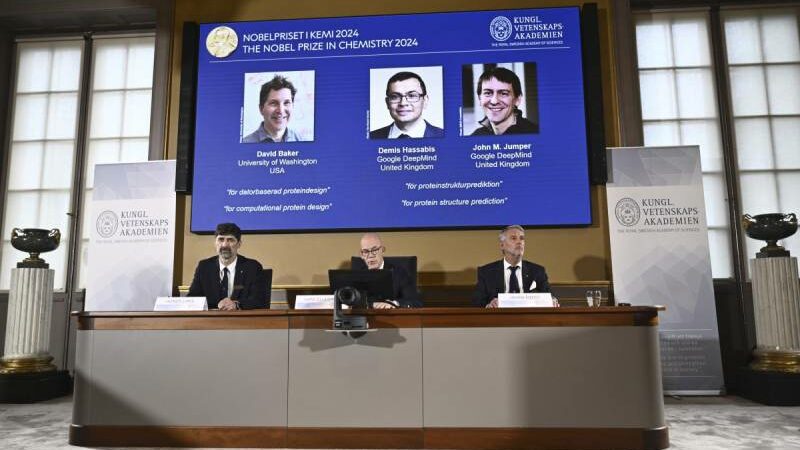Two Google DeepMind scientists and an American biochemist have been awarded the 2024 Nobel Prize in Chemistry for their groundbreaking work in predicting and designing protein structures.
Half of the prize will go to Demis Hassabis, the British founder of DeepMind, and John Jumper, who led the development of the company’s AI model AlphaFold, which predicts protein structures based on their chemical sequences.
The other half will go to Professor David Baker of the University of Washington, whose computational research has led to the creation of entirely new types of proteins used in vaccines, nanomaterials and miniature sensors.
The winners were announced by the Royal Swedish Academy of Sciences in Stockholm and will share the prize of 11 million Swedish kronor (£810,000) for computer-aided protein design and protein structure prediction.
Heiner Linke, chairman of the Nobel Committee for Chemistry, said: “One of the discoveries being recognised this year concerns the construction of spectacular proteins. The other is about fulfilling a 50-year-old dream: predicting protein structures from their amino acid sequences. Both of these discoveries open up vast possibilities.”
Speaking at a press conference shortly after the announcement, Baker said he was woken up by a phone call from the Academy informing him of the award, and that developing a completely new protein was an ambition that began as a dream more than 20 years ago. Advances in computing and scientific understanding during this time have paved the way for this vision to have a major impact on the world, such as developing new vaccines against coronaviruses, he said.
“We glimpsed at the beginning that it might be possible to create a whole new world of proteins that address a lot of the problems faced by humans in the 21st century,” Baker said. “Now it’s becoming possible.”
Proteins control and drive all the chemical reactions that form the basis of life. They act as hormones, antibodies, and building blocks of various tissues. Baker’s mission was to develop new proteins that do not exist in nature, and he succeeded in 2003. Since then, his group has generated novel proteins that can be used for a variety of applications in medicine and materials science.
Proteins generally consist of 20 different amino acids bound to each other in long chains that fold into a three-dimensional structure. These structures and chemical compositions determine how proteins interact with each other and whether they will bind drugs in the body. Since the 1970s, scientists have been working to predict the three-dimensional structure of proteins based on their chemical sequence, but the problem is notoriously difficult and progress has been slow.
A breakthrough came four years ago. In 2020, Hassabis and Jumper announced the development of an AI model called AlphaFold 2. Using this technology, researchers were able to predict the structures of nearly all of the 200 million proteins they had identified. Since its breakthrough, AlphaFold 2 has been used by more than 2 million people in 190 countries for applications such as understanding antibiotic resistance and developing enzymes that can break down plastics.
Dr. Annette Doherty, President of the Royal Society of Chemistry, said: “The benefits of this research are remarkable, as we can all look forward to applications improving our health and wellbeing. I am sure that their work will prove as inspirational to future generations as the discoveries of their predecessors who have been awarded this most prestigious honour.”
- Google doodle celebrates the chess, a dynamic game played on 64 black and white squares - November 25, 2024
- How Artificial Intelligence is Changing Marketing Strategies in 2024 - November 23, 2024
- Kendrick Lamar Releases ‘GNX’ a New Album Features SZA, Jack Antonoff and Kamasi Washington - November 23, 2024





